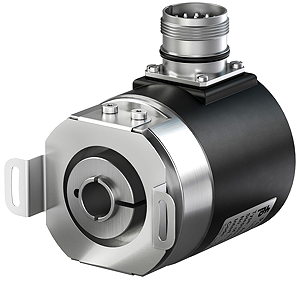The 58mm-diameter device is the first to combine two electromagnetic principles – the Hall effect and the Wiegand effect – in one encoder. This combination is said to result in a wear-free sensor that is reliable, even in extreme conditions.
When a permanent magnet field is rotated near a Wiegand sensor, it changes the direction of a magnetic field at the core of the sensor. This, in turn, induces a voltage in a coil around the sensor, producing the energy to power to the electronics that count the shaft revolutions. There is no need for batteries and the encoders do not lose rotational data if the power is removed. When the power is restored, accurate position values are available.
As with other magnetic encoders, the contact-free operation eliminates the need for glass disks and mechanical gears, resulting in compact devices that need no maintenance.

Pepperl+Fuchs' new encoder combines two electromagnetic effects
The encoders have a cycle time of less than 80µs, making them ideal for dynamic applications. They are available with interfaces for EtherCat, Profinet and SSI.

